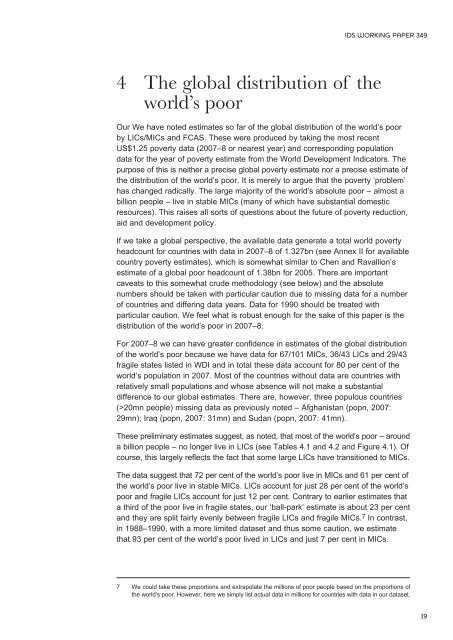Andy Sumner - Institute of Development Studies
Andy Sumner - Institute of Development Studies
Andy Sumner - Institute of Development Studies
Create successful ePaper yourself
Turn your PDF publications into a flip-book with our unique Google optimized e-Paper software.
IDS WORKING PAPER 3494 The global distribution <strong>of</strong> theworld’s poorOur We have noted estimates so far <strong>of</strong> the global distribution <strong>of</strong> the world’s poorby LICs/MICs and FCAS. These were produced by taking the most recentUS$1.25 poverty data (2007–8 or nearest year) and corresponding populationdata for the year <strong>of</strong> poverty estimate from the World <strong>Development</strong> Indicators. Thepurpose <strong>of</strong> this is neither a precise global poverty estimate nor a precise estimate <strong>of</strong>the distribution <strong>of</strong> the world’s poor. It is merely to argue that the poverty ‘problem’has changed radically. The large majority <strong>of</strong> the world’s absolute poor – almost abillion people – live in stable MICs (many <strong>of</strong> which have substantial domesticresources). This raises all sorts <strong>of</strong> questions about the future <strong>of</strong> poverty reduction,aid and development policy.If we take a global perspective, the available data generate a total world povertyheadcount for countries with data in 2007–8 <strong>of</strong> 1.327bn (see Annex II for availablecountry poverty estimates), which is somewhat similar to Chen and Ravallion’sestimate <strong>of</strong> a global poor headcount <strong>of</strong> 1.38bn for 2005. There are importantcaveats to this somewhat crude methodology (see below) and the absolutenumbers should be taken with particular caution due to missing data for a number<strong>of</strong> countries and differing data years. Data for 1990 should be treated withparticular caution. We feel what is robust enough for the sake <strong>of</strong> this paper is thedistribution <strong>of</strong> the world’s poor in 2007–8.For 2007–8 we can have greater confidence in estimates <strong>of</strong> the global distribution<strong>of</strong> the world’s poor because we have data for 67/101 MICs, 36/43 LICs and 29/43fragile states listed in WDI and in total these data account for 80 per cent <strong>of</strong> theworld’s population in 2007. Most <strong>of</strong> the countries without data are countries withrelatively small populations and whose absence will not make a substantialdifference to our global estimates. There are, however, three populous countries(>20mn people) missing data as previously noted – Afghanistan (popn, 2007:29mn); Iraq (popn, 2007: 31mn) and Sudan (popn, 2007: 41mn).These preliminary estimates suggest, as noted, that most <strong>of</strong> the world’s poor – arounda billion people – no longer live in LICs (see Tables 4.1 and 4.2 and Figure 4.1). Ofcourse, this largely reflects the fact that some large LICs have transitioned to MICs.The data suggest that 72 per cent <strong>of</strong> the world’s poor live in MICs and 61 per cent <strong>of</strong>the world’s poor live in stable MICs. LICs account for just 28 per cent <strong>of</strong> the world’spoor and fragile LICs account for just 12 per cent. Contrary to earlier estimates thata third <strong>of</strong> the poor live in fragile states, our ‘ball-park’ estimate is about 23 per centand they are split fairly evenly between fragile LICs and fragile MICs. 7 In contrast,in 1988–1990, with a more limited dataset and thus some caution, we estimatethat 93 per cent <strong>of</strong> the world’s poor lived in LICs and just 7 per cent in MICs.7 We could take these proportions and extrapolate the millions <strong>of</strong> poor people based on the proportions <strong>of</strong>the world’s poor. However, here we simply list actual data in millions for countries with data in our dataset.19
















